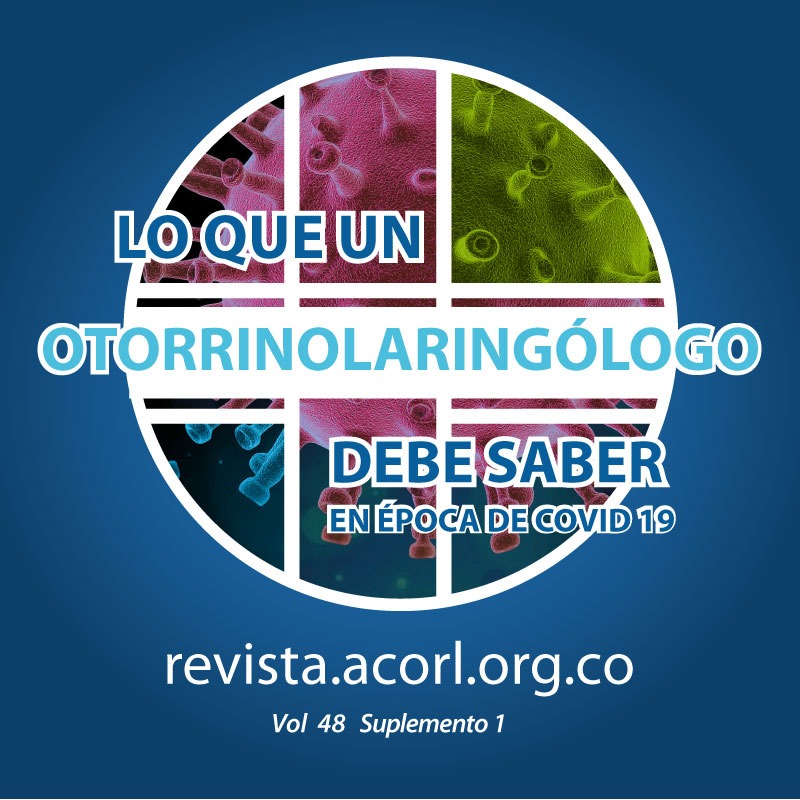Facial Plastic Surgery in Covid Times 19
Main Article Content
Abstract
Otolaryngology and facial plastic surgery are specialties have been affected directly by the pandemia of the coronavirus SARS Covid 2/Covid 19. Facial plastic surgeons have close contact with nasal mucosa, oral cavity and nasopharynx during the physical examination, the performance of office procedures and during functional and cosmetic surgery, elevating the risk of exposure and infection due to the high concentrations of Covid 19 virus found in these anatomic sites.
Currently, national and international parameters are being established to try and define which are the best biosafety parameters and protective personal equipment (PPE) to be able to reopen outpatient clinics, perform minimally invasive procedures and eventually elective surgical procedures in the area of facial plastic surgery. A plan will be presented implementing guidelines trying to guarantee the highest security standards for the patient and the health workers.
The timing to re-open facilities will depend mainly on the evolution of the pandemic and the availability of medical and surgical facilities in the different areas of the country. Despite this, it becomes important to start establishing the necessary changes to be able to offer health services with the highest standards of quality and security for patients, administrative and health personnel
Downloads
Article Details
Este artículo es publicado por la Revista Acta de Otorrinolaringología & Cirugía de Cabeza y Cuello.
Este es un artículo de acceso abierto, distribuido bajo los términos de la LicenciaCreativeCommons Atribución-CompartirIgual 4.0 Internacional.( http://creativecommons.org/licenses/by-sa/4.0/), que permite el uso no comercial, distribución y reproducción en cualquier medio, siempre que la obra original sea debidamente citada.
eISSN: 2539-0856
ISSN: 0120-8411
References
Lu D, Wang H, Yu R, Yang H, Zhao Y. Integrated infection control strategy to minimize nosocomial infection of
coronavirus disease 2019 among ENT healthcare workers. J Hosp Infect. 2020;S019567012030092X.
Chang D, Xu H, Rebaza A, Sharma L, De la Cruz CS. Protectinghealth-care workers from subclinical coronavirus infection. Lancet Respir Med. 2020;8(3):e13.
Zou L, Ruan F, HuangM, et al. SARS-CoV-2 viral load inupper respiratory specimens of infected patients. N Engl J Med. 2020;382(12):1177-1179. doi:10.1056/NEJMc2001737
Xu K, Lai XQ, Liu Z. [Suggestions for prevention of 2019 novel coronavirus infection in otolaryngology head and necksurgery medical staff]. Zhonghua Er Bi Yan Hou Tou Jing WaiKe Za Zhi. el 2 de febrero de 2020;55(0):E001.
Wang, J., Du, G. COVID-19 may transmit through aerosol. Irish Journal of Medical Science. March, 2020.
Plan de acción en la atención de consulta en el periodo posterior a la crisis Covid 19 en cirugía plástica, estética, y reparadora. Sociedad Española de Cirugía Plástica Reparadora y estética(SECPRE). Abril 2020.
Protocolo de atención a pacientes durante la contingencia por SARS-Cov 2/ COVID 19 en el consultorio de medicina estética. Sociedad Colombiana de Medicina Estética. Abril 2020.
Recommendations on clinical activity during the SARSCoV-2 pandemic. Sociedade Portuguesa de Cirurgia Plastica Reconstructiva e Estetica. Abril 2020.
Considerations for the Resumption of elective Sugery and Vistis. American society of Plastic Surgeons. Abril 2020. Disponible en: www.plasticsurgery.org
Ministerio de Salud y Protección Social de Colombia. Resolución 666. Abril 24 de 2020. Abril 2020.
How to risk-stratify elective surgery during the COVID -19pandemic? Stahel P. BMC Open Access (2020) 14:8 https://doi.org/10.1186/s13037-020-00235-9
Lei S, Jiang F, Su W, Chen C, Chen J, Mei W, et al. Clinical characteristics and outcomes of patients undergoing surgeries during the incubation period of COVID-19 infection.EClinicalMedicine.2020;100331.

